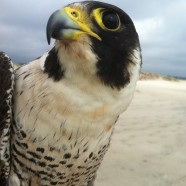
Earthspan principals conduct long-term studies on migrating tundra Peregrine Falcons (Falco peregrinus tundrius) at Assateague Island, MD/VA (autumn since 1970) and Padre Island, TX (autumn and spring since autumn 1977). In 2019 we entered into a partnership with The Peregrine Fund to continue these studies. We have expended 59,010 man-hours of survey time in observing 75,304 peregrines and capturing 16,851. The tundra peregrine made a significant recovery and has been removed from the list of endangered species yet continued monitoring of populations is imperative. Because of the continuity and standard method for data collection these surveys have become an essential tool in that effort. Our database at Assateague includes sightings of every other raptor we have observed on the Island since 1970. Some 90% of all observations there have been recorded by three experienced individuals who have also conducted springtime studies at Padre Island. At Padre a more diverse cast of highly qualified individuals has participated.
Our work in these studies with satellite-received telemetry allows us to continue elucidating previously undescribed aspects of the tundra peregrine’s wintering biology and continental migration and to identify critical habitats. Given available technologies, Assateague and Padre remain ideal laboratories in which to study and address present and future issues of concern to peregrines, other Neotropical migrants, and humans. We increment and maintain an archive comprising thousands of peregrine blood samples that we have used to study genetics, demographics, contaminants and emerging pathogens. In recent years we have studied infectious pathogens such as West Nile Virus and Avian Influenza in partnership with U.S. Government entities and addressed contaminants through studies related to the 2010 Gulf oil spill.
Blood and feather samples collected from peregrines contribute to collaborative mercury monitoring efforts. We began an effort with Utah State University in 2022 to document Avian Influenza exposure in migrant peregrine falcons through the seroprevalence of associated antibodies and indicate if some individuals survive infection. We tested 442 samples and 6 birds had antibodies. For spring and fall 2021 which is the period before the AI outbreak started, the combined number of positives is 1 out of 179 birds (0.56%, which is similar to past studies). For Spring 2022, Fall 2022, and Spring 2023, the outbreak period, the combined number of positive birds is 4/205 (1.95%). The number of birds with antibodies remains very low, but higher than reported in past surveys. The percentage of peregrines with antibodies in past studies in the US was 1/472 (0.2%) in 2006 to 2010, and 2/299 (0.67%) in 2001 to 2004. The only encouraging news is that AI exposure is not invariably fatal to peregrines, although most succumb rapidly.
In 2008 our database allowed us to provide an Expert Declaration on the Draft Environmental Assessment and Management Plan for Take of Migrant Peregrine Falcons in the United States for Use in Falconry. Among other points, we concluded that the standardized average number of migrating peregrines we observed at Assateague over the preceding 29 years was essentially the same as that seen more than six decades ago (1939-1944), before DDT had serious adverse effects on the reproductive potential of the peregrine in North America. Our work at Assateague and Padre Islands represents the bulk of tundra Peregrine Falcons banded within the continental United States since the establishment of the Bird Banding Laboratory by the Department of the Interior. Furthermore, our overall database constitutes the most significant and longest continuous monitoring study on this falcon in the Americas. Long-term studies such as ours are essential to monitoring the stability of wildlife populations, particularly in light of rapid changes that may occur due to contaminants, infectious diseases, habitat loss, climate change and other factors. By the long-term and standardized nature of our studies, we have established levels of observation in stable populations that will quickly raise future concerns if not achieved over a several year period.
Assateague Survey 2024 – Between 25 September and 18 October, the survey team of Mike Yates and Bill Seegar expended 233 man-hours in the field, recording 106 sightings of peregrines and capturing 27 different individuals. Three of the falcons captured were previously banded, all marked as nestlings from the eastern population established through captive breeding and release. The 106 sightings included 34 observations of individuals previously captured during the survey. By unit effort (per 10 man-hours), sightings were the 7th lowest and captures the 3rd lowest among our 54 survey years, a disappointing continuance of our recent downturn in numbers.
A major concern has been that populations are adversely affected by the Highly Pathogenic Avian Influenza (HPAI) outbreak of 2021-24. A long-term survey on Alaska’s Yukon River has also shown a concurrent decrease. Since 1973 Skip Ambrose has surveyed 165 miles of the upper Yukon and documented a recovery from 12 to over 60 pairs of peregrines by 2012. In 2023-2024 adults were noticeably missing; in 2024 a third of eyries were unoccupied and multiple others had only single birds. Among 75 territories Ambrose monitored in 2012-2019 an average of 77% were occupied by a pair. By 2024 that percentage had dropped to only 43%.
We know that HPAI is almost invariably fatal to peregrines that become exposed. They are not colonial birds and thus contract HPAI only through infected prey. We also know that waterfowl and shorebirds are highly susceptible to HPAI and that peregrines single out compromised individuals. There is also a disparity in prey selection by adult peregrines versus juveniles, with higher percentages of shorebirds taken by the former and passerines by the latter. These facts provide context to recent reports from other sources. There was high turnover among adults in VA in 2024, highest at coastal eyries where peregrines rely more upon shorebirds as prey. Nest site fidelity is very high among peregrines, and those missing adults are dead. Two coastal eyries became unoccupied and second-year females were at two sites, suggesting the normal supply of non-breeding adult “floaters” that usually replace missing breeders is depressed. Two dead adults recovered in VA tested positive for HPAI, and the USDA reported 50 such confirmed cases of peregrine deaths nationwide since 2023. High adult replacement rates were also reported in NJ. There were either at least one new breeder or no breeders at all at 50% of their 44 nest sites in 2024, and 63% at coastal sites. The normal adult replacement rate in NJ is 15%, and a second-year pair attempted to nest at one site.
In response to the alarm raised by Ambrose and others (including our reduced numbers at Assateague and Padre Islands), an internet group was established to encourage peregrine researchers worldwide in redoubling efforts to monitor peregrine breeding and survey metrics and exchange results. In 2024 the normal 16-18 pairs in WA’s San Juan Islands were reduced to five active eyries, and only two of those produced young. Peregrines feed heavily on waterfowl in the Puget Sound area, and postmortems on seven recovered falcons confirmed HPAI as the cause. Other findings from the internet group were that MT recorded a 48% reduction in 2023 occupied sites, 40 pairs in NM had dropped to 28 from 2016 to 2023, and NV had seen a 43% decline among 28 monitored territories.
At Assateague juveniles sighted per 10 man-hours were 3.78, our 10th lowest number ever and well below our 54-year average of 7.15. Adults sighted per 10 man-hours were only 0.38, and only our first three of 53 full surveys recorded a lower number. Our 54-year average is 1.25 adults sighted per 10 man/hours. While 2024 was a very poor showing of adults at Assateague, the age demographic of those adults is an added concern. All four adults captured were in their second year, and one of those was a VA native and not a tundra peregrine. This means only five observed (but not captured) falcons could have been full adult tundra peregrines. As we have previously outlined concerns that adults are more at risk of HPAI mortality due to preferred prey, it would have been more reassuring to have a confirmed full adult or two represented in our sample.
The Survey’s peregrine numbers at Assateague are reduced over the past several years, but it is difficult to assess how much of the reduction is attributable to HPAI-related reductions in population. The island itself has become less hospitable to most migrating raptors, as evidenced by our own observations. Anthropogenic degradation of the island as a prime migration stopover through management and increased public use are among the complicating factors. 2024 Asstg Rept
Padre Surveys 2024 – During the spring migration period Yates, Seegar and Doney surveyed the South Padre Island Unit of Laguna Atascosa National Wildlife Refuge from 11 April through 03 May, conducting 262 survey hours in the field over 23 survey days. Surveys recorded 204 peregrine falcon observations and 21 captures, including 3 seasonal recaptures. Among new captures, 13 (72 %) peregrines were first banded this spring and 5 (28 %) were previously banded. Four of those were Padre Returns marked during the 2022-2023 Surveys, and one a second-year falcon banded as a 2023 nestling in Ashland, Wisconsin. Blood and feather samples were collected from individuals, supporting collaborative studies of peregrine health, genetics and migratory origins. Adults comprised 33% of new captures. The minimum average area stopover duration among seasonal recaptures was 10.3 days, ranging from 1 to 17 days. Our seasonal sighting rate of 7.79 peregrine observations per 10 survey hours is well below the spring 45-year mean of 16.21 (± 6.23 SD).
During the fall migration Gregg Doney’s team surveyed South Padre Island from 24 September through 26 October, conducting 394 survey hours in the field over 33 days. Surveys recorded 457 peregrine falcon observations and 117 captures, including 69 color-marked resights and 16 seasonal recaptures. Among new captures, 99 (98%) peregrines were first banded and 2 (2%) were previously banded Padre Returns marked during the 2022-2023 Surveys. Blood and feather samples were collected from individuals, supporting collaborative studies of peregrine health, genetics and migratory origins. Adults comprised 9% of new captures. The minimum average area stopover duration among seasonal recaptures was 4 days, ranging from 1 to 13 days. Our seasonal sighting rate of 9.85 peregrine observations per 10 survey hours is within, but close to the lower bounds of, the 47-year mean of 15.71 (± 5.56 SD).
Survey counts and capture rates continued to decline in 2024 from a 2016 peak and even more sharply in spring, possibly with related age structure variation among migrants. Similar patterns are emerging at Assateague Island. Among recent 3-year comparisons to total means, spring observations and captures have declined 36% and 61% respectively, and fall rates 34% and 31%. In 2024 spring observation rates dropped 51% and fall rates 37%.
In relation to age structure, the percent of adult falcons captured during spring and fall seasons has declined uniformly by about 50% to present. Declines were gradual among fall seasons at Padre since 2018, but the adult composition of migrants declined abruptly during the 2024 spring season. In addition, an annual age index of the few Padre Returns (known age recaptures) has also steadily declined since 2018. Altogether these patterns of declining populations with age structure variation heighten the concerns for northern migratory peregrine populations that concentrate at Padre Island during migration. 2024 Padre Report
